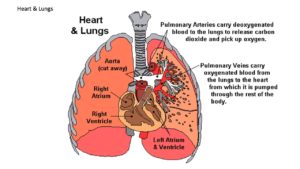Overview
Introduction
The respiratory system enables us to produce energy by supplying the body with a continuous supply of oxygen. It is also responsible for eliminating carbon dioxide, a byproduct of cell metabolism. Whereas oxygen is necessary for human and animal respiration, carbon dioxide is necessary for plant respiration. Plants take in carbon dioxide and release oxygen, their waste product, and the cycle of interdependence between plants and animals continues. (Contrary to what certain authoritarians will tell you, carbon dioxide is not a pollutant, and is just as necessary to the cycle of life as oxygen.)
 In the lesson on the circulatory system we learned that the four-chambered human heart is divided into two separate pumps, the “right heart” and the “left heart.” The right heart (consisting of the right atrium and ventricle) collects deoxygenated blood returning from the body by way of the veins and pumps it through the lungs where carbon dioxide is eliminated and fresh oxygen is picked up. From the lungs, the newly oxygenated blood is collected by the left heart (the left atrium and ventricle) and is pumped, by way of the aorta, throughout the body to supply the cells with oxygen and to collect carbon dioxide for elimination the next time through. In the lesson on the circulatory system we learned that the four-chambered human heart is divided into two separate pumps, the “right heart” and the “left heart.” The right heart (consisting of the right atrium and ventricle) collects deoxygenated blood returning from the body by way of the veins and pumps it through the lungs where carbon dioxide is eliminated and fresh oxygen is picked up. From the lungs, the newly oxygenated blood is collected by the left heart (the left atrium and ventricle) and is pumped, by way of the aorta, throughout the body to supply the cells with oxygen and to collect carbon dioxide for elimination the next time through. |
|---|
The purpose of the lungs is to . . .
A. supply the body with oxygen.
B. eliminate nitrogen from the body.
C. eliminate carbon dioxide from the body.
D. both A and C.
E. all of the above.(Select the best answer and click on the “Continue” button.)

